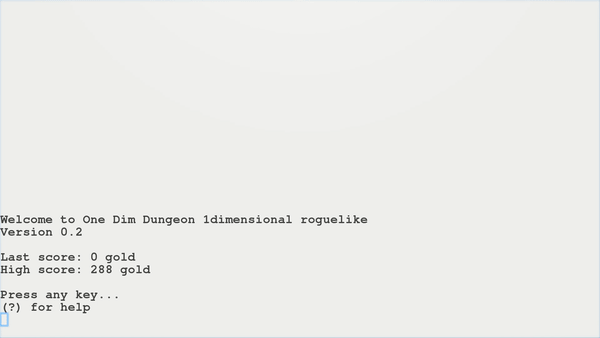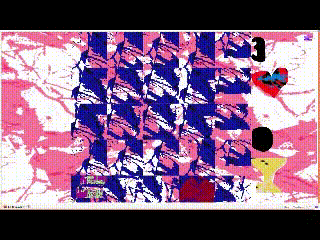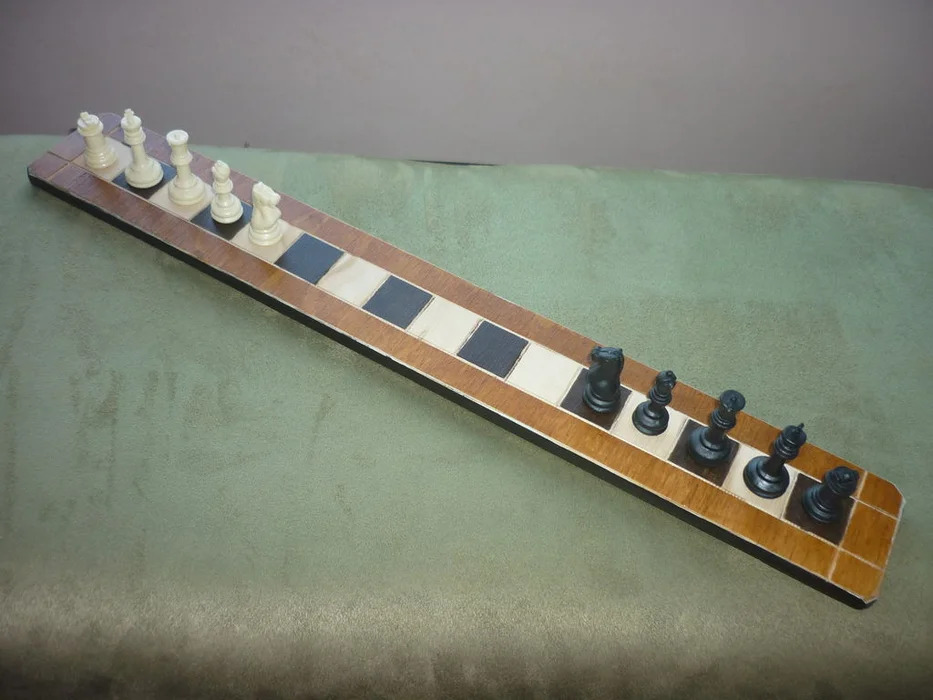Update: 2020-10-01: Link to Slides from my talk Lower Dimensional Dungeons for Roguelike Celebration 2020
Update 2020-6-30: I’ve added a link to the game on Github.
Update 2020-07-04: In my own 1dimensional dungeon I’ve refactored the code, added specific montser behaviors and colors, added more potions and updated the gif preview of gameplay below. The gameplay is much more advanced than what I originally described below.
Update 2020-7-07: Created a short and minimal one-dimensional hardware version of another game, Hunt The Wumpus. My version Hunt the Wimpus has a writeup here and emulator here (read the instructions first).

Over the past few days I built my first working oldschool ASCII roguelike game, which I call One Dim Dungeon (aka One Dimensional Dungeon).
You can download it from GitHub here.
A roguelike is a specific genre of game. Going on about 40 years as a genre, they are distinguished by turn-based gameplay instead of continuous action; simple tile graphics or often ASCII text as stand-in for features; algorithmically-generated increasingly-difficult levels, enemies, objects and other gameplay elements; no ability to save your status, which is known as permadeath. There are some other associated themes and gameplay mechanics as well, the essentialness of which is often hotly (and perhaps unneccesarily) debated by fans.
I think at this point I’ve tried to make a roguelike game in this style at least 5 or 6 times. Other than the time I worked through the libtcod python tutorial each time I’ve tended to start from scratch and try to implement each feature of this genre by hand. Several of my past attempts have been very simple, and not quite compelling gameplay.

hellth, a mini roguelike I made in p5.js
To be honest, my current game One Dim Dungeon is not the most obviously compelling game. It certainly wouldn’t be as well-loved by someone other than me. But there’s some surprise and delight on my end, and a sense of triumph of creating my first working roguelike prototype, and doing it on my own from scratch, in Javascript.
Creating a complete roguelike without a pre-made library or game engine is a layer of difficulty not recommended! I’ve attended Roguelike Celebration, and I’m aware that Entity Component Systems are de riguer, and I’d love to have made that, but instead I built improvisationally, without a complete understanding of all of the systems and mechanics, which produced significant anti-patterns. This means I have an anti-robust system and all of the bugs and spaghetti code that entails. Now that I have a baseline I’m looking forward to adapting this start and turning it into such a system eventually. Or perhaps I’ll start again some point in the future!
As opposed to 99% of other roguelikes, I made a strange choice: this is a 1-dimensional roguelike. You can only go forward and back. Why? It’s easier to implement than having to procedurally build out and manage an entire 2d grid level, building out rooms procedurally. I thought I’d simplify with constraint in order to allow me to concentrate on essential mechanics that still felt within the domain of the genre.
Here are some of my game mechanics:
procedurally generated floors
The map is algorithmically generated anew each game, and each time you descend the stairs (<) to a new floor. I chose some magic number percentages so that each turn there is a certain percent chance that a monster could be spawned along an edge or gold could be spawned in the dungeon. I’ve adopted the full set of lowercase and uppercase letters as standins for monsters. Their power is determined when they get spawned, based on probabilities relating to the strength of the player and the level they are found on.
Turn-based
I used the javascript readline function so that my whole game loop runs each time a button is pressed. This is a pretty simple mechanic.
Permadeath
Permadeath means that when you lose, you restart from the beginning. I print out the player’s stats and save them to the filesystem in a score file that is printed the next time the game is played.
ASCII graphics
This alone is quite a hassle because it means I keep trying to work with the commandline for output/’drawing’. This is a tradition in roguelikes, a genre going on 40 years old, and its age shows. ASCII text is charming to many who are fans, including me, but downright offputting to the majority of casual players. I thought I’d make a system that could be played in the terminal, as well as in the browser if I implement my own graphics with the browser’s canvas and the p5.js library I use so often, but I haven’t completed that yet.
I don’t have much experience with Curses, the standard text-mode interface library for the Terminal, or npm’s blessed package. Instead I chose to clear the screen after each button press. This little hack saved me some research time and implementation though is worth revisiting later.
Gameplay
Each time the player descends a floor there is a chance that gold can be present (*) on the level and there will almost definitely be monsters (k, b, m, T, etc..) present. While the player moves around there is a chance each turn that additional monsters can be spawned and appear by walking from the edge of the dungeon. Monsters have various levels of aggression, which determines if they approach or attack the player. To attack a monster, a player simply walks into a monster. When a monster dies it is removed. Text descriptions of events and game stats are printed above the game area. No two games are exactly the same as each level will be a different length, have different monsters, items, and values. The game ends when the player is killed (usually) or if the player makes it down to the 16th level and grabs the amulet of Yendor. By the way, this quest goal is a standard mechanic in classic roguelikes, and I thought I’d keep it in for this game.
(update 7-4-2020: I added a ton of potions, monster-specific attacks, colors, hallucination, vertical and horizontal and flip-flop orientation mode, debugging options and more)
I have future plans of a one-dimensional roguelike that plays more like a walking sim or flatgame where instead of monsters and attacks you meet poets and or partake in conversations. Well, I stuck to the stereotypes of the genre for this one.
More one-dimensional games
I was a big fan of the one-dimensional puzzle roguelike game Cosmic Crown by Alice L. Unfortunately, it is no longer available for iOS and I haven’t been able to get the web version to work. Cosmic Crown has 8bit graphics and animation and polished gameplay. Rather than a hack-and-slash style roguelike with monsters it features puzzles like leaping past toxic sludge, razor sharp blades and the like.
Roguelike game developer Santiago Zapata was challenged to create an entire roguelike game in the space of a tweet on Twitter. In other words, a game with entire sourcecode in 280 characters or less. His Rogue280v2 is an impressive version (use arrows to move), and simpler but bears resemblance to my own 1dimensional roguelike (note: his is several years earlier!). He has an earlier v1 280 character version as well, where you can only see the player and stairs, and an even more minimal 140-character game mdc (additional info ) from the time period when Twitter capped tweets at 140 chars. This earlier version is notable in that there is no displayed visible level; only your stats are presented: your power, level, and whether you’ve discovered the stairs. As Santiago says, “If you didn’t get it you need a bit more imagination 😉.” These games are impressive even as their terse code is hard for me to decipher.

Santiago Zapata’s Rogue280v2. The game’s code entirely fits in a tweet. Display here shows stats (Health 35, Level 3) and the board (player, terrain and an altar).
In a web search I was able to find another one-dimensional ASCII roguelike, one that was created in less than a day in a jam. It’s Stutter Step, a pretty minimal game by Evgenii Petrov. Incidentally, if you’re looking for gameplay ideas in making a one-dimensional roguelike, there are some tips and ideas from a 2013 forum post here (backed up just in case here: 1 2.
One other strange minimalist one-dimensional game is the celebrated Line Wobbler!
Line Wobbler is by Robin Baumgarten. It is not a roguelike because the gameplay remains the same each time rather than different levels and puzzles created procedurally. But it is a very silly dungeon-crawler with preset levels and puzzles (or enemies) played using a spring door stop as a controller and a long beautiful multi-color LED strip as the display.
Wikipedia helpfully describes a dungeon crawl game as a type of scenario in fantasy role-playing games in which heroes navigate a labyrinth environment (a “dungeon”), battling various monsters, avoiding traps, solving puzzles, and looting any treasure they may find.
Line Wobbler was included in the UCLA Game Art Festival I curated at the Hammer Museum several years ago. I also live close to Wonderville, the bar and indie arcade in Brooklyn, and have been able to play the game there a few dozen times. It’s a delight to play. I love the strong connection between the player’s handling of the vibrating door stop controller and the motion of the colored dot (‘the player’) travelling along the one-dimensional LED strip.
More one-dimensional games and resources
Corey Johnson made URL Hunter, also using ASCII text. The game is played in a website’s URL bar. You are a hunter (O) trying to capture animals (a) by pressing the spacebar. Click the link and look at the URL to begin playing.
There are several one-dimensional chess variations. There is a version designed by mathematician and puzzle-maker Martin Gardner. I wrote about his game Hexapawn previously in my post on chess variants. Gardner’s games and many other one-dimensional chess variants are listed on the Chess Variant Pages (and backed up here). One Ring Chess is another strange variant built along a loop.

1dimensional chessboard, image, tutorial and new rules by Alex Z
One day I’d love to make my own hardware one-dimensional roguelike. Robin Baumgarten gave a talk on the making of Line Wobbler for A MAZE several years ago.
Game creator Will of 14hour lunch break made One Dimensional Arcade which includes one-dimensional versions of Tetris, Frogger, and Breakout. I didn’t find them much of a challenge.
Wolfenstein 1d looks pretty silly. There is video of the gameplay.
_\<
( >
__)(
_____/ // ___
/ \\ / \\__
| _ // ||
| | \ \\ / _ ||
| | | \/ | \ ||
| |_/ |/ | | ||
| | \ /| |_/ ||
| | \ \| | >_ )
| | \. _|\ | < _|=
| /_.| . \/
* | * ** / * ** |)/) **
\))ejm97/.,(//,,..,,\||(,wo,\ ).((//
- \)
You died!
You were killed by a jackal on level 2
You killed: 10 monsters and found 3 gold.
goodbye